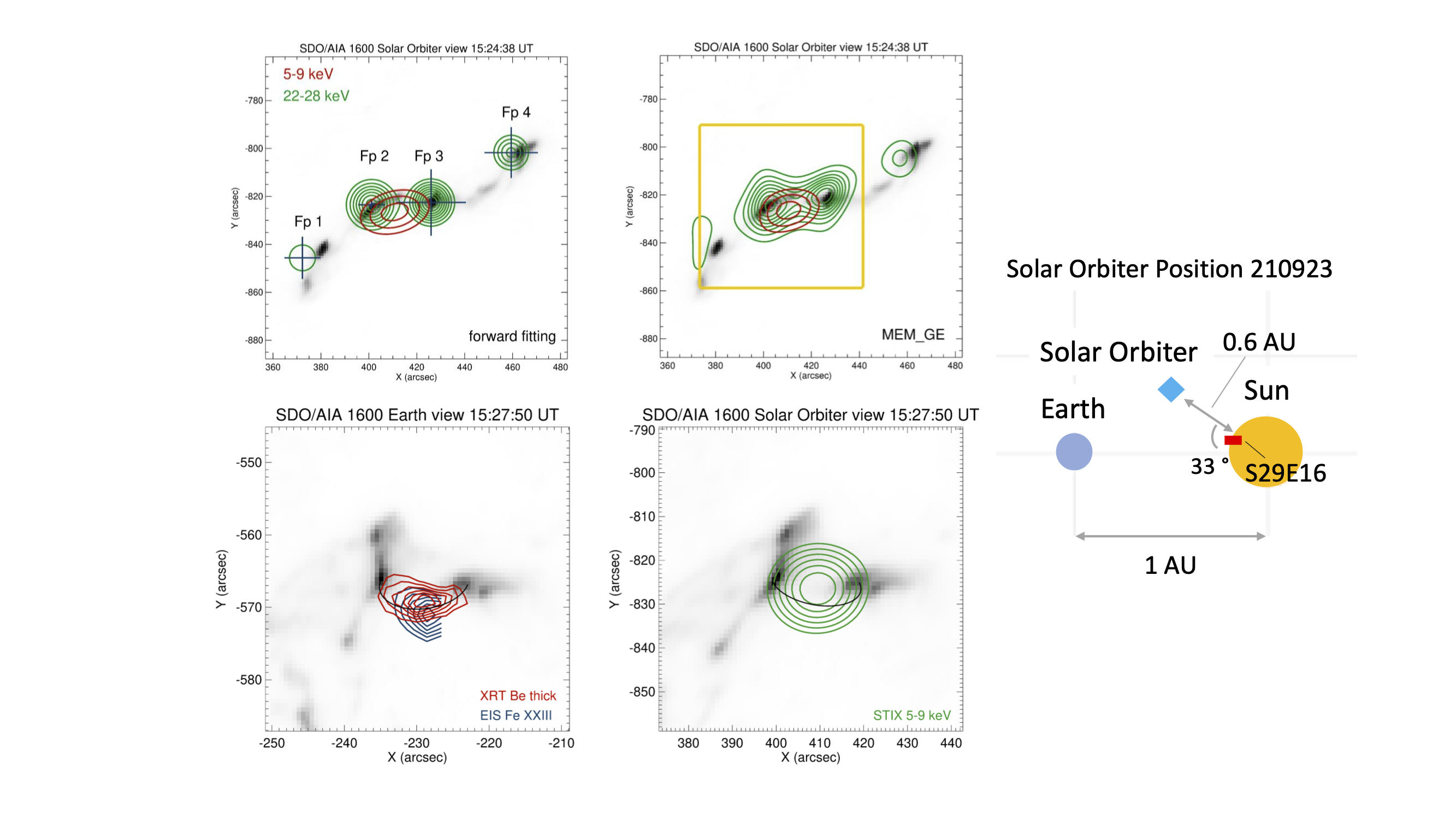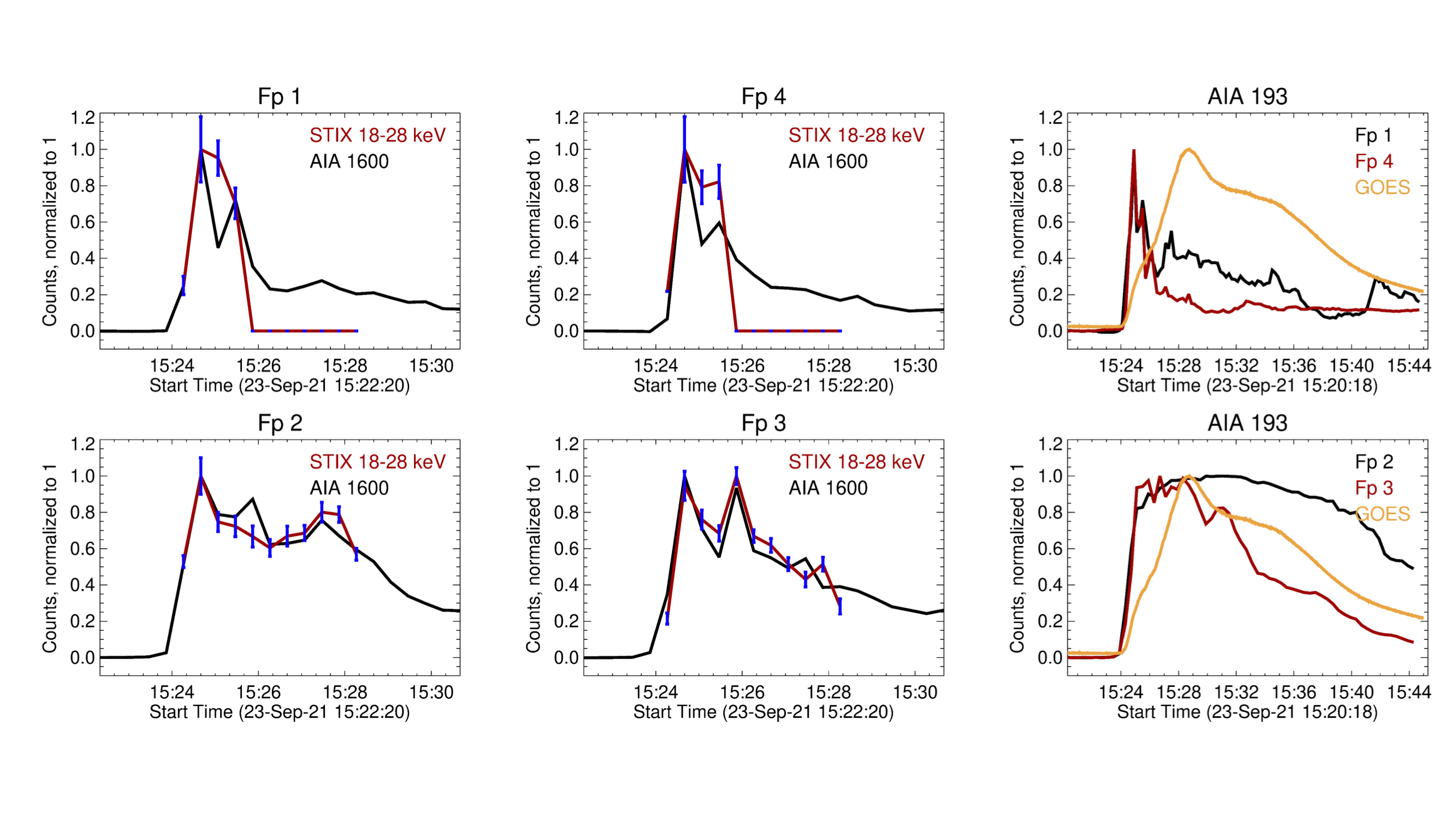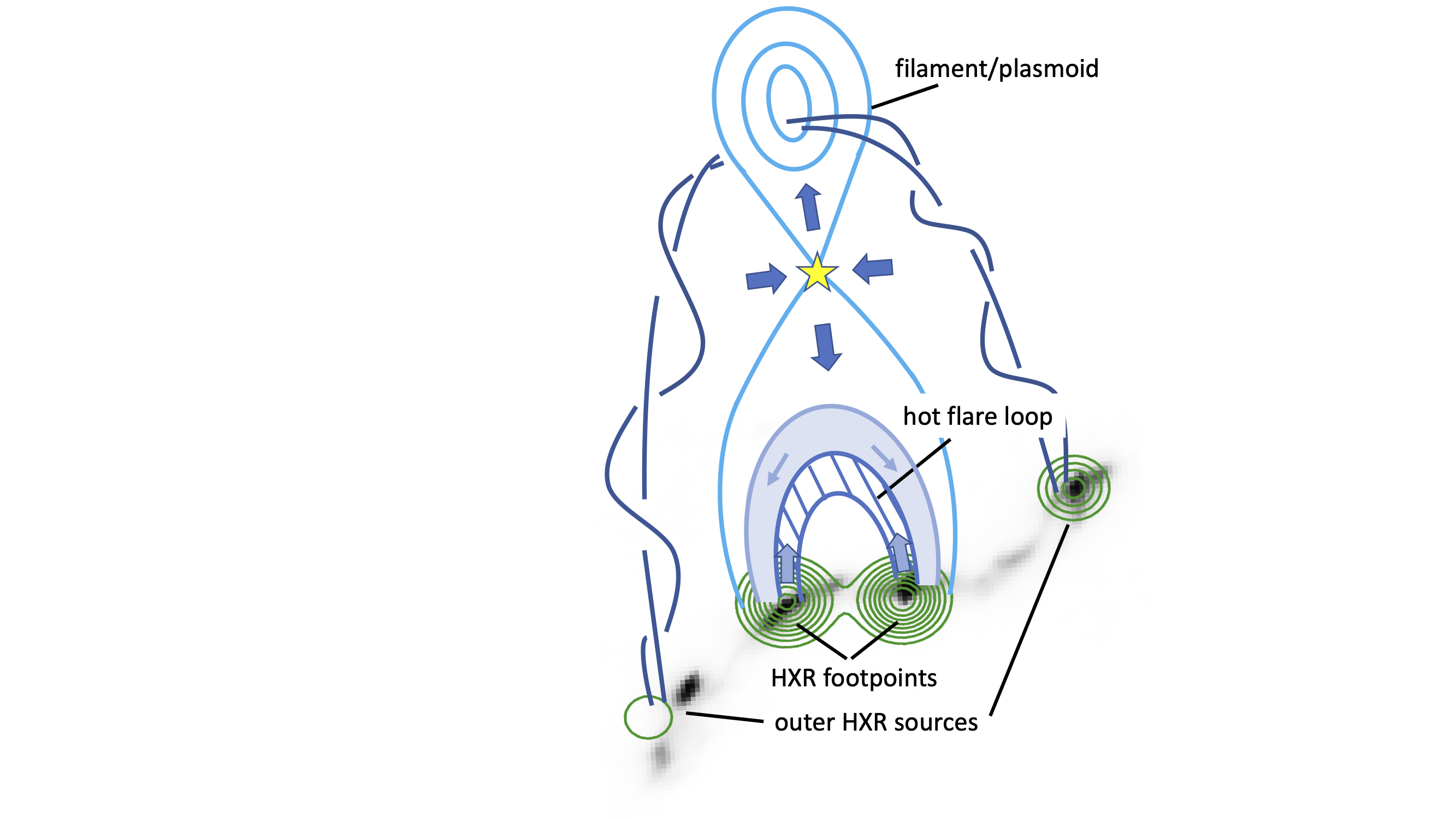Science nugget: Solar flare hard X-rays from the anchor points of an eruptive filament - Solar Orbiter
Solar flare hard X-rays from the anchor points of an eruptive filament
(Solar Orbiter nugget #13 by Muriel Zoë Stiefel1,2, and the Solar Orbiter/STIX team)
Introduction
The hard X-ray imaging spectrometer (STIX; [1]) on Solar Orbiter [2] observes solar flares in the hard X-ray energy range carrying on the observations of its predecessor RHESSI [3]. Here we give an overview of the analysis of a M1.8 GOES class flare as reported in Stiefel et al. (2023) [4]. The flare was jointly observed by many space observatories: AIA/SDO [5], XRT/Hinode [6], EIS/Hinode [7], IRIS [8] and STIX on board Solar Orbiter. Making this flare special is that we report four individual sources observed by STIX at nonthermal hard X-ray energies.
Method
We conducted a multi-wavelength analysis of the flare in the EUV and X-ray energy range using the detectors and satellites listed above. STIX uses an indirect imaging technique providing us with the visibilities - the Fourier components - of the image of a flaring X-ray source. The reconstruction of an actual image (meaning the conversion from Fourier space back to normal [x,y] depiction of the image) is done on Earth using different imaging algorithms (e.g. Back-projection, forward-fitting, MEM_GE, see [9]).
The flare
We analyzed SOL2021-09-23T15:28, a M1.8 flare. This was the largest flare jointly observed by Hinode, SDO and Solar Orbiter spacecraft in the time range February to October 2021. The detailed study of this flare was motivated by the observation of four individual sources on the STIX images in the nonthermal energy range, shown from 22 to 28 keV. In the two upper images of Figure 1 the contours show the reconstructed STIX images during the peak of the nonthermal energy range. The further analysis of this flare was driven by the goal to understand the role of these four sources especially in the context of the standard model for solar flares.

Figure 1. Images showing the flaring region using the AIA 1600 Å map. The two upper images show the reprojected AIA 1600 Å map during the onset of the impulsive phase. Overlaid are the contours of the reconstructed STIX images in the thermal (red, 50-90 % contours) and nonthermal (green, 20-90 % contours) energy ranges using the forward-fitting and the MEM_GE algorithms. The yellow box indicates the field of view of the two images below. These two images are a comparison between the Earth and the Solar Orbiter vantage points during the peak time of the thermal energy. Overlaid on the AIA 1600 Å map are the 40-90 % contours of XRT (red), EIS (red) and thermal STIX (green). The black loop indicates a potential flare loop, making it easier to understand the two different viewing points. The illustration to the right shows the relative locations of the Sun, the Earth, and Solar Orbiter.
To understand the geometry of the flare, we analyzed the thermal sources observed by XRT, EIS, AIA and STIX (5-9 keV) during the peak time of the thermal energy. The two images at the bottom of Figure 1 compare the thermal sources as seen from Earth perspective with XRT, EIS and AIA 1600 Å and Solar Orbiter view points with STIX and AIA 1600 Å (reprojected). We clearly see a flare loop in the EIS and XRT filters and in the thermal energy range 5-9 keV of STIX connecting the two footpoints visible in AIA 1600 Å. These two footpoints correspond to "Fp 2" and "Fp 3" noted in the upper left image, showing the well known standard model for solar flares with the flare loop and its footpoints.
To explore further the similarities and differences among the four sources, we compared the time evolution of the intensities measured by AIA and STIX at the location of each. Figure 2 shows the comparison between the individual sources and detectors. We can observe striking differences between the outer sources (Fp 1 and Fp 4) and the inner sources (Fp 2 and Fp 3). While the outer sources increase and decrease rapidly, the inner sources have longer decay times.

Figure 2: Time evolution plots with maximum value normalised to one. The left and middle column show the intensity plots of AIA 1600 Å (black) and nonthermal STIX (red, error bars in blue) for the four sources individually. The right column shows the intensity plots of AIA 193 Å (black and red) for the four sources. As a reference, we added the GOES soft X-ray light curve (orange).
Conclusions
From the observations we can clearly recognise that the inner sources (Fp 2 and Fp 3) show similar behaviour and are the footpoints of a flare loop as known from the standard model for solar flares. The outer sources (Fp 1 and Fp 4) show different behaviour compared to the inner sources. Combining our observations outlined above with further studies (see [2]) of the CME and the measurement of the Doppler velocities, we deduce that the outer sources are likely the anchor points of an eruptive filament. The outer sources are produced by flare-accelerated electrons that precipitate down the filament and emit Bremsstrahlung in the chromosphere. Figure 3 shows a cartoon of our results, combining the standard model for solar flares with the measurements of the flare presented here. Hard X-ray sources of an eruptive filament where already predicted by [10]. [11] reports similar observations for a flare in the microwave range making our observations the first report of these outer anchor points in the hard X-ray range measured by STIX on Solar Orbiter.

Figure 3: Cartoon describing the flare during the onset of the impulsive phase. The background image is the same image as shown in Figure 1 (top left). Additionally the sketch shows the standard model for solar flares.
Affiliations
1 Institute for Data Science, University of Applied Sciences and Arts Northwestern Switzerland (FHNW), Bahnhofstrasse 6, 5210 Windisch, Switzerland
2 Institute for Particle Physics and Astrophysics (IPA), Swiss Federal Institute of Technology in Zurich (ETHZ), Wolfgang-Pauli-Strasse 27, 8039 Zurich, Switzerland
References
[1] Krucker et al. (2020) A&A, 642, A15
[2] Müller et al. (2020), A&A, 642, A1
[3] Lin et al. (2002) Sol. Phys., 210, 3
[4] Stiefel et al. (2023) A&A 670, A89
[5] Lemen et al. (2012), Sol. Phys. 275, 17
[6] Golub et al. (2007), Sol. Phys., 243, 63
[7] Culhane et al. (2007), Sol. Phys., 243, 19
[8] De Pontieu et al. (2014), Sol. Phys., 289, 2733
[9] Massa et al. (2023) in preparation, preprint on arxiv
[10] Shibata et al. (1995) ApJ 451 L83
[11] Chen et al. (2020) ApJL 895 L50
- Removed a total of (31) style text-align:left;
- Removed a total of (3) style margin:0;
Nuggets archive
2025
09/04/2025: Bursty acceleration and 3D trajectories of electrons in a solar flare
02/04/2025: Picoflare jets in the coronal holes and their link to the solar wind
19/03/2025: Radial dependence of solar energetic particle peak fluxes and fluences
12/03/2025: Analysis of solar eruptions deflecting in the low corona
05/03/2025: Propagation of particles inside a magnetic cloud: Solar Orbiter insights
19/02/2025: Rotation motions and signatures of the Alfvén waves in a fan-spine topology
12/02/2025: 'Sun'day everyday: 2 years of Solar Orbiter science nuggets that shed light on some of our star's mysteries
22/01/2025: Velocity field in the solar granulation from two-vantage points
15/01/2025: First joint X-ray solar microflare observations with NuSTAR and Solar Orbiter/STIX
2024
18/12/2024: Shocks in tandem : Solar Orbiter observes a fully formed forward-reverse shock pair in the inner heliosphere
11/12/2024: High-energy insights from an escaping coronal mass ejection
04/12/2024: Investigation of Venus plasma tail using the Solar Orbiter, Parker Solar Probe and Bepi Colombo flybys
27/11/2024: Testing the Flux Expansion Factor – Solar Wind Speed Relation with Solar Orbiter data
20/11/2024:The role of small scale EUV brightenings in the quiet Sun coronal heating
13/11/2024: Improved Insights from the Suprathermal Ion Spectrograph on Solar Orbiter
30/10/2024: Temporally resolved Type III solar radio bursts in the frequency range 3-13 MHz
23/10/2024: Resolving proton and alpha beams for improved understanding of plasma kinetics: SWA-PAS observations
25/09/2024: All microflares that accelerate electrons to high-energies are rooted in sunspots
25/09/2024: Connecting Solar Orbiter and L1 measurements of mesoscale solar wind structures to their coronal source using the Adapt-WSA model
18/09/2024: Modelling the global structure of a coronal mass ejection observed by Solar Orbiter and Parker Solar Probe
28/08/2024: Coordinated observations with the Swedish 1m Solar Telescope and Solar Orbiter
21/08/2024: Multi-source connectivity drives heliospheric solar wind variability
14/08/2024: Composition Mosaics from March 2022
19/06/2024: Coordinated Coronal and Heliospheric Observations During the 2024 Total Solar Eclipse
22/05/2024: Real time space weather prediction with Solar Orbiter
15/05/2024: Hard X ray and microwave pulsations: a signature of the flare energy release process
01/02/2024: Relativistic electrons accelerated by an interplanetary shock wave
11/01/2024: Modelling Two Consecutive Energetic Storm Particle Events observed by Solar Orbiter
2023
14/12/2023: Understanding STIX hard X-ray source motions using field extrapolations
16/11/2023: EUI data reveal a "steady" mode of coronal heating
09/11/2023: A new solution to the ambiguity problem
02/11/2023: Solar Orbiter and Parker Solar Probe jointly take a step forward in understanding coronal heating
25/10/2023: Observations of mini coronal dimmings caused by small-scale eruptions in the quiet Sun
18/10/2023: Fleeting small-scale surface magnetic fields build the quiet-Sun corona
27/09/2023: Solar Orbiter reveals non-field-aligned solar wind proton beams and its role in wave growth activities
20/09/2023: Polarisation of decayless kink oscillations of solar coronal loops
23/08/2023: A sharp EUI and SPICE look into the EUV variability and fine-scale structure associated with coronal rain
02/08/2023: Solar Flare Hard Xrays from the anchor points of an eruptive filament
28/06/2023: 3He-rich solar energetic particle events observed close to the Sun on Solar Orbiter
14/06/2023: Observational Evidence of S-web Source of Slow Solar Wind
31/05/2023: An interesting interplanetary shock
24/05/2023: High-resolution imaging of coronal mass ejections from SoloHI
17/05/2023: Direct assessment of far-side helioseismology using SO/PHI magnetograms
10/05/2023: Measuring the nascent solar wind outflow velocities via the doppler dimming technique
26/04/2023: Imaging and spectroscopic observations of EUV brightenings using SPICE and EUI on board Solar Orbiter
19/04/2023: Hot X-ray onset observations in solar flares with Solar Orbiter/STIX
12/04/2023: Multi-scale structure and composition of ICME prominence material from the Solar Wind Analyser suite
22/03/2023: Langmuir waves associated with magnetic holes in the solar wind
15/03/2023: Radial dependence of the peak intensity of solar energetic electron events in the inner heliosphere
08/03/2023: New insights about EUV brightenings in the quiet sun corona from the Extreme Ultraviolet Imager








































 Sign in
Sign in
 Science & Technology
Science & Technology